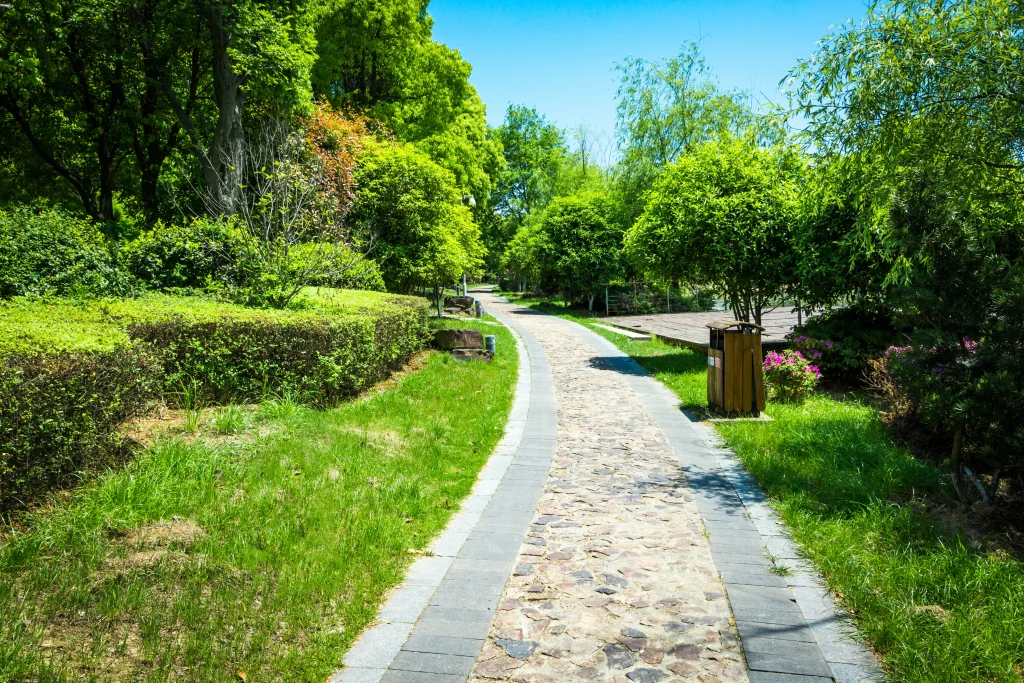For new sod fertilizer, you’ll want to use a starter fertilizer that’s high in phosphorus (P) to encourage root development. Look for an NPK ratio like 10-20-10 or 12-24-12. Avoid high-nitrogen fertilizers initially, as they promote top growth at the expense of root establishment – a critical mistake in our region’s conditions.
Fertilizing new sod properly stands as one of the most critical steps in ensuring long-term lawn success. Throughout this guide, you’ll learn exactly when to fertilize your new sod for maximum root development, what specific products perform best in Denver’s environment, and how to apply fertilizer correctly to avoid common pitfalls.
Should I Fertilize My New Sod?
Yes, you should fertilize your new sod – but timing matters significantly. Proper lawn fertilization supports essential root development and helps your sod establish quickly in our challenging Denver climate.
Fertilizing new sod differs from maintaining established lawns:
- Fresh sod remains vulnerable to salt and nitrogen stress during its rooting phase.
- Using standard lawn fertilizers too soon often leads to burned edges, yellowing patches, and compromised root systems.
- The root zone needs phosphorus-rich formulas rather than high-nitrogen products that stimulate top growth before the root system can support it.
New sod requires patience and precision when it comes to fertilization. A strategic approach yields a lawn that establishes faster and develops deeper drought resistance for our semi-arid environment.
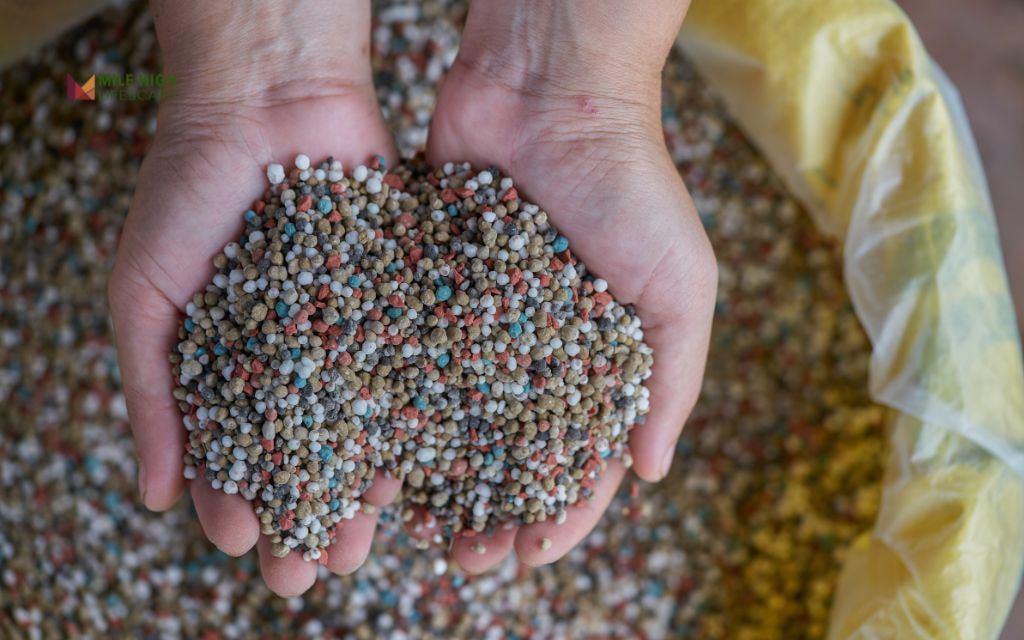
When to Apply New Sod Fertilizer
Timing fertilizer application correctly makes the difference between thriving turf and struggling patches. Follow this Denver-specific timeline for optimal results:
- Installation Day: Apply no fertilizer. Focus on proper soil contact and consistent watering. The sod arrives with some nutrients from the farm – adding more now risks burning tender roots.
- 2-3 Weeks Post-Installation: Once your sod shows signs of rooting (slight resistance when gently tugged), apply a starter fertilizer with higher phosphorus content (such as a 10-20-10 formula). This timing allows roots to establish while providing nutrients for continued development.
- 6-8 Weeks After Installation: Transition to a balanced, slow-release fertilizer (20-10-10) to support both root and blade development as your lawn matures.
- Climate Consideration: Denver’s variable spring and fall weather requires flexibility. Delay fertilization during heat waves (temperatures above 85°F) or unexpected cold snaps, as extreme conditions limit nutrient uptake and increase stress.
Pro Tip: Apply fertilizer when air temperatures remain consistently between 60 – 80°F for optimal nutrient absorption. Early morning application works best in Denver to avoid midday heat and allow nutrients to settle before evening temperature drops.
Choosing the Right New Sod Fertilizer: What to Look for
Selecting the proper fertilizer for new sod in Denver requires understanding both what your turf needs and what our local conditions demand.
Key Features to Look For
- High phosphorus content (the middle number in the NPK ratio) promotes strong root development, essential for new sod to anchor into Denver’s often clay-heavy soils.
- Slow-release nitrogen formulations prevent burning and provide steady nutrition as the sod establishes.
- Low salt index products reduce root stress, particularly important in our semi-arid climate where salts can accumulate.
- Micronutrients like iron and manganese address common deficiencies in Denver’s alkaline soils.
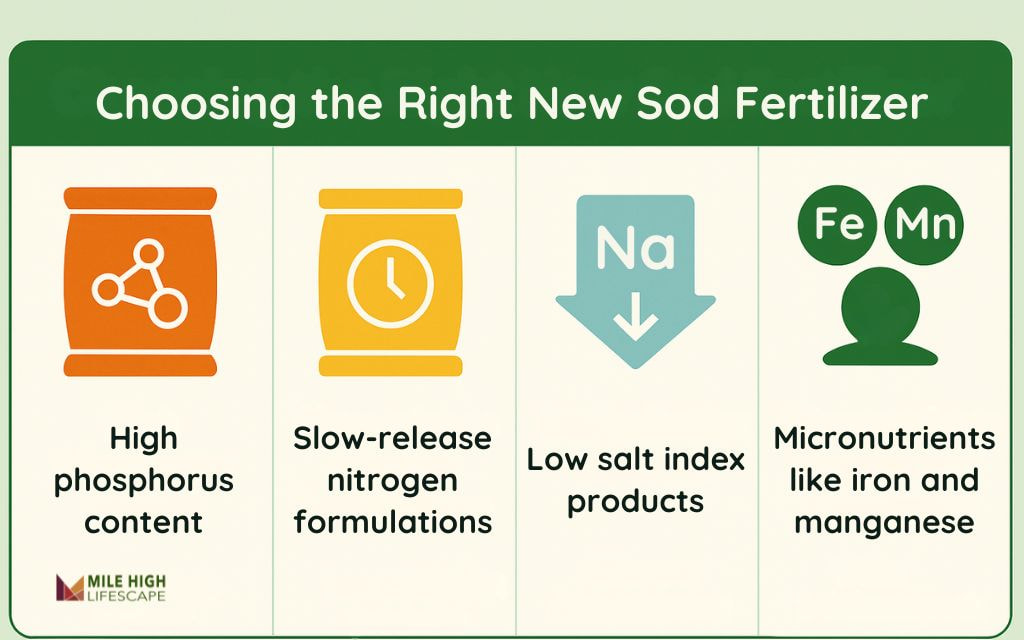
What to Avoid
- Standard lawn maintenance fertilizers with high nitrogen content (anything above 30-0-0) that push blade growth at the expense of root development.
- Weed-and-feed combinations containing pre-emergent herbicides that stress establishing turf.
- Quick-release formulas that deliver nutrients too rapidly for new roots to process efficiently.
Recommended Products for Denver’s Conditions
| Product | NPK Ratio | Benefits for Denver Sod | Application Rate |
| Scotts Turf Builder Starter | 24-25-4 | High phosphorus for root development, works well in clay soil | 4 lbs per 1,000 sq ft |
| Lesco Starter Fertilizer | 18-24-12 | Balanced formula with extended release, good for high altitude | 5 lbs per 1,000 sq ft |
| Espoma Organic Lawn Starter | 3-4-3 | Gentle organic option, ideal for homes with pets/children | 7 lbs per 1,000 sq ft |
These products account for Denver’s unique soil composition and climate challenges while providing the necessary nutrients for new sod establishment.
How to Apply Fertilizer to New Sod (Safely and Effectively)
Proper application technique ensures your new sod fertilizer reaches the roots where needed while preventing waste and potential damage.
Step 1: Confirm Root Establishment
Wait until your sod shows clear signs of rooting before applying fertilizer. Test by gently tugging on a corner – if you feel resistance, roots have begun establishing and fertilization can proceed.
Sod typically takes 2-3 weeks to reach this stage, depending on season and watering practices.
Step 2: Choose Optimal Conditions
Select a cool, dry morning with minimal wind for application. Denver’s afternoon thunderstorms and winds can disrupt even fertilizer distribution or cause runoff before nutrients penetrate the soil. Temperatures between 60-70°F provide ideal conditions for nutrient uptake.
Step 3: Calibrate Your Spreader
Use a broadcast or drop spreader for even distribution. Calibrate according to the product specifications on the label. For uneven terrain, a broadcast spreader typically provides more consistent coverage across slopes and grades.
Step 4: Apply Fertilizer With Precision
Walk at a steady pace, making perpendicular passes to ensure complete coverage. Reduce the application rate by half and make two passes in opposite directions for maximum evenness. This technique prevents streaking and burnt patches common with new sod applications.
Step 5: Water Thoroughly
Irrigate immediately after fertilizing with ½ inch of water to dissolve granules and carry nutrients to the root zone. Dry climate necessitates thorough watering to prevent fertilizer burn and activate slow-release components.
Step 6: Clean Equipment
Thoroughly rinse your spreader to prevent corrosion and cross-contamination with future products. Fertilizer residue can damage equipment and potentially harm your lawn during subsequent applications.
Safety Note: Wear gloves during application and wash hands thoroughly afterward. Keep children and pets off the lawn until watered in completely, approximately 24 hours after application.
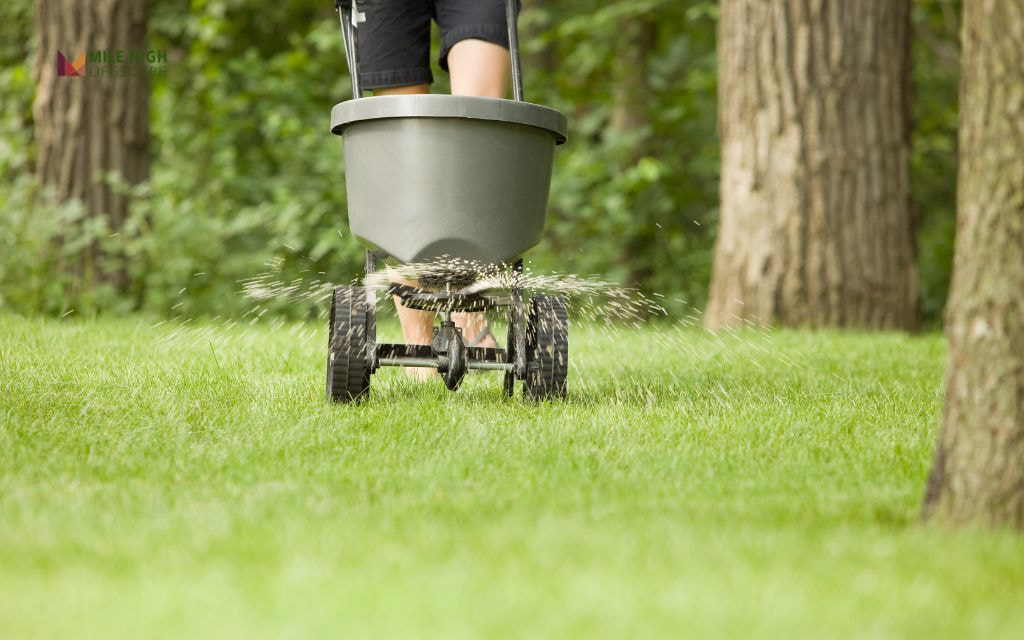
Organic and Eco-Friendly New Sod Fertilizer Options
Organic fertilizers offer significant advantages for new sod in Denver’s challenging environment, particularly for homeowners concerned about environmental impact, water quality, or household safety.
Organic options deliver nutrients more slowly than synthetic alternatives, reducing the risk of burn while improving long-term soil structure. This gradual release matches well with new sod’s developing ability to uptake nutrients and supports microbial activity in Denver’s often biologically-sparse soils.
For Denver homeowners with pets or young children, organic products provide peace of mind with reduced chemical exposure after application. Additionally, these formulations support water conservation efforts by increasing soil’s organic matter content and water-holding capacity.
Recommended Organic Options for Denver Lawns:
- Milorganite (6-4-0) works exceptionally well in our region, providing slow-release nitrogen and iron that helps counter our alkaline soil conditions while establishing new turf.
- Espoma Organic Lawn Starter Fertilizer combines natural ingredients specifically formulated for root development and early lawn establishment with no risk of burning.
- Locally-produced compost tea supplies beneficial microorganisms that enhance root development and improve soil structure – particularly valuable for Denver’s clay soils.
- While organic fertilizers typically work more slowly than synthetic options, they build long-term soil health and drought resilience – particularly valuable in our water-conscious region.
Post-Fertilization Tips: Monitoring, Watering & Mowing
After fertilizing your new sod, proper follow-up care ensures maximum nutrient uptake and continued establishment.
- Water deeply within 30 minutes of fertilizing, applying at least ½ inch of water to dissolve granules and move nutrients into the root zone. Denver’s low humidity can cause fertilizer to dry on leaf surfaces, potentially causing burn.
- Delay mowing for 48-72 hours after application to allow nutrient absorption without additional stress. When mowing, maintain a height of 3-3.5 inches – slightly higher than typical recommendations – to promote deeper root growth in our challenging climate.
- Monitor your lawn for signs of uneven growth or discoloration in the weeks following fertilization. Pale yellow patches may indicate insufficient water, while dark green streaks suggest uneven fertilizer distribution.
- Adjust irrigation based on weather conditions. Increase watering during hot, dry periods to prevent stress during nutrient uptake.
- Document your fertilization date and product used for future reference. Creating a lawn care calendar specific to your property helps establish an effective maintenance routine aligned with Denver’s growing seasons.
- Resume your regular maintenance schedule approximately 8 weeks after installation, when the sod has fully established and rooted deeply.
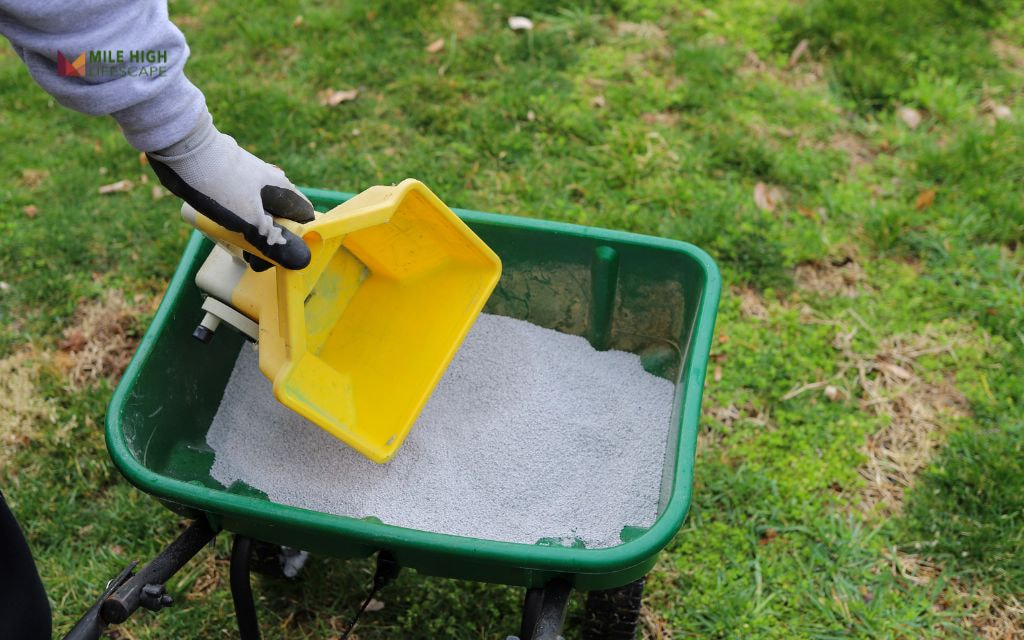
Common Problems and How to Avoid Them
Understanding potential fertilization issues helps you prevent damage to your investment in new sod.
Fertilizer Burn
Fertilizer burn on a lawn is characterized by yellow or brown edges on grass blades. This condition results from applying too much fertilizer or fertilizing during extreme heat.
Solution: Always water thoroughly after application and avoid fertilizing when temperatures exceed 85°F – a common summer occurrence in Denver.
Uneven Growth
Patches of darker and lighter green indicate inconsistent fertilizer distribution.
Solution: Use a properly calibrated spreader and apply in perpendicular passes to ensure uniform coverage across your lawn.
Nutrient Runoff
Heavy rain or excessive irrigation after application can wash fertilizer into storm drains before absorption.
Solution: Check weather forecasts before application and water lightly but sufficiently to activate fertilizer without creating runoff.
Stunted Root Development
Excessive nitrogen promotes blade growth at the expense of roots.
Solution: Use phosphorus-rich starter fertilizers specifically designed for new turf establishment.
Local Climate Factor
Denver’s intense UV radiation accelerates the breakdown of some fertilizer components.
Solution: Apply new sod fertilizer before 10 AM or after 6 PM to maximize effectiveness and prevent potential leaf scorch during nutrient uptake.
Conclusion
Fertilizing new sod represents a critical investment in your lawn’s long-term health. The unique challenges of Denver’s environment demand a tailored approach to new turf establishment.
By following the timing, new sod fertilizer selection, and application techniques outlined in this guide, you’ll promote faster establishment, deeper root systems, and greater drought tolerance in your new lawn. Remember that patience pays dividends – rushing the process often leads to setbacks that take months to correct.
For homeowners seeking personalized sod installation and maintenance in Denver, Mile High Lifescape offers comprehensive lawn care consultations tailored to your specific property conditions and landscape goals. Our expertise in Denver’s unique growing environment ensures your investment thrives from day one.
Frequently Asked Questions (FAQs)
How soon do you fertilize new sod?
It’s generally recommended to wait 2-3 weeks after installation before applying starter fertilizer to new sod in Denver. This timing allows the roots to establish initial contact with the soil while reducing stress during the critical establishment phase.
What is the best fertilizer for newly planted sod?
New sod needs a starter fertilizer high in phosphorus (the middle number in the NPK ratio). Products with ratios like 10-20-10 or 18-24-12 promote root development essential for establishment. For Denver’s alkaline soils, choose fertilizers containing iron and sulfur to address common deficiencies and improve nutrient availability.
What should I put on the sod after laying it?
After laying sod, focus on consistent watering during the first 3 weeks, applying enough moisture to keep the soil consistently damp but not saturated. Once roots begin establishing (2-3 weeks), apply a starter fertilizer high in phosphorus. Consider a light application of compost tea to introduce beneficial microorganisms that enhance root development in Denver’s clay soils.
Should I put starter fertilizer under sod?
Apply starter fertilizer to the soil before laying sod, incorporating it into the top 2-3 inches for immediate access by developing roots. Additionally, include gypsum (calcium sulfate) at a rate of 40 pounds per 1,000 square feet to improve Denver’s clay soil structure and encourage deeper, healthier root systems.
What happens if you fertilize sod too soon?
Fertilizing sod too soon after installation can burn developing roots, delay establishment, and create patchy growth. The salt content in fertilizers draws moisture away from tender roots when applied before they’ve had a chance to establish soil contact.
